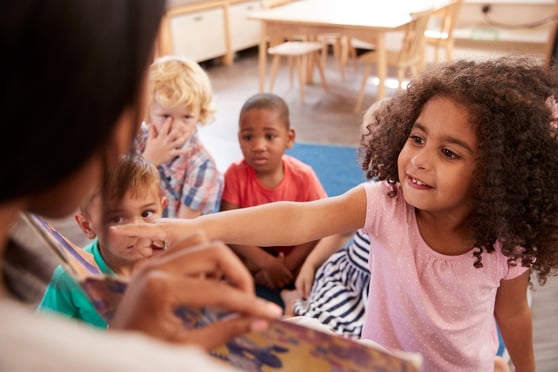
5 Easy Math Engagement Strategies for the Classroom
The news headlines are daunting. Math scores are down. School districts are scrambling to turn things around. And...
ALI Staff | Published March 29, 2024
Storytelling is one of the oldest forms of communication as a way to share experiences, understand others, and entertain. It can also be a powerful learning tool, especially in early childhood education.
Stories have the ability to connect young learners to the content in a more relatable way. They’re also a fun, engaging approach to learning that requires little more than a good narrative linked to your objectives. They also work in tandem with play-based learning.
Why is storytelling important in early childhood education? Let’s take a look at the importance of stories in the classroom and story-based learning as a teaching tool.

Story-based learning is an educational approach that weaves narratives into the learning process. The idea is that when information is embedded within a compelling story, students engage with that information on a deeper level.
A higher level of engagement means better understanding, retention, and application of that new knowledge. Stories also make learning more fun, and any approach that makes learning more enjoyable is bound to be an effective teaching tool.
Storytelling is important in early childhood because it engages children, cultivates language development, and taps into children’s imaginations. Through narratives, children can explore their emotions, expose themselves to new worlds and ideas, and develop a passion for learning.
The benefits of storytelling go deeper than engagement, although that’s certainly a huge perk. Let’s take a closer took at the top benefits of storytelling for your youngest learners.
Storytelling has a number of noted brain benefits in young students. Stories can stimulate the imagination as students visualize what they see and hear, boost memory skills, and lay a foundation for more complex cognitive processes down the line.
Through exposure to rich language and plot structures in stories, children can expand their vocabularies, improve their listening comprehension, and start developing early literacy skills. This doesn’t just support language acquisition. It builds the foundation for a love of reading.
Storytelling can be used as a tool for social-emotional learning. Narratives that explore complex emotions, social dynamics, and topics like empathy, resilience, and self-awareness can support students’ emotional intelligence.
Children who see and hear stories are able to use their innate curiosity to envision worlds and visualize what they’re thinking. This is a great way to foster a student’s creative thinking and develop skills that could support innovation and project-based learning in later grades.
Diverse stories introduce students to new traditions, cultures, and perspectives they may not have been exposed to otherwise. This can foster empathy, respect, and appreciation for the differences in young learners that they carry with them.
On top of the social-emotional aspects of storytelling, storytelling as a group activity can promote cooperation, communication, and collaboration. Students must use skills like active listening, turn-taking, and sharing to participate.
Stories that engage students are a more active approach to learning. Connect to students on an even deeper level with student-led discussions or retellings about stories, props, or visuals to support their learning. You can make stories accessible to all of your students.
Engaging stories allow students to build on concentration skills and create pathways for deeper connections with new content. Relatable stories or stories that tap into student interests are an even stronger introduction to literacy and a story-based approach.
Ready to tap into student imaginations? Story-based tools like Kide Science use playful inquiry to connect students to science, math, literacy, and social-emotional concepts in an engaging way. Captivate learners with ready-made lesson plans for your classroom.
Now that you’ve heard about the benefits of storytelling in education, you can think about how story-based learning can fit within your classroom. The key is making content more accessible for children. That includes tapping into their interests with stories you know will spark curiosity.
Think about the questions you know your students have about the world around them and lead them on their path of discovery through stories. The basics behind the importance of storytelling are the basics behind phenomenon-based learning, too. These are student-driven tools that give students the opportunity to experience content rather than simply hear about it.
It can also be about exposing children to stories that feature novel ideas. Linda Liukas, the author and illustrator of Hello Ruby, a children’s book about a little girl’s love for technology, loves the idea of expanding students’ worldview through storytelling.
Want to hear more? Listen to Liukas talk more about tapping into students’ imaginations in this podcast with the author.
Here are some takeaways:
Stories are important in education because they can serve as a point of connection for students. They can certainly be used to entertain, but they’re also a great way to inform, engage, and make complex concepts accessible and relatable.
Through narrative storytelling, students explore diverse perspectives, sharpen their critical thinking skills, and develop empathy. Stories foster language skills and ignite imaginations, especially in our youngest learners.

The news headlines are daunting. Math scores are down. School districts are scrambling to turn things around. And...

Math assessment in California is changing. What used to be a compliance exercise or reporting tool is now becoming a...

You know the moment: a student’s eyes light up when the science experiment fizzes or the math puzzle helps them...